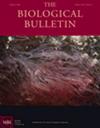Adaptive and Plastic Responses to Environmental Variation: Introduction to a Virtual Symposium in The Biological Bulletin.
IF 1.9
4区 生物学
Q2 BIOLOGY
引用次数: 0
Abstract
Climate change is rapidly restructuring communities and altering the distribution of biodiversity along coastlines worldwide.While many species have undergone range shifts to track their niche, other taxa may adapt to, or tolerate, the changing conditions in which they find themselves. Forecasting the biological responses of coastal systems to global change is critical, given the ecological disruption to diverse communities (Zhang et al., 2017. Proc. R. Soc. B Biol. Sci. 284: 20171772), the importance of their resources to global food security (Costello et al., 2020. Nature 588: 95–100), and the vulnerable ecosystem services provided by coastal taxa (He and Silliman, 2019. Curr. Biol. 29: R1021–R1035). However, such forecasting efforts are challenged by key differences between aquatic (marine and freshwater) and terrestrial organisms, including their life histories and physical properties of their respective environments (Pinsky et al., 2019.Nature 569: 108–111; Shlesinger andLoya, 2019. Science 365: 1002–1007). Over the past decade, researchers have built upon syntheses of prior efforts (e.g., Hoffmann and Sgro, 2011. Nature 470: 479–485; Doney et al., 2012. Annu. Rev. Mar. Sci. 4: 11–37) to better predict evolutionary responses of coastal ecosystems to climate change, leading to novel insights (Munday et al., 2013. Ecol. Lett. 12: 1488–1500; Baltar et al., 2019. Trends Ecol. Evol. 34: 1022–1033) and new research networks (e.g., https://rcn-ecs.github.io). However, challenges remain for exploring organismal and community responses to future conditions in aquatic habitats. To effectivelymodel the response of diverse organisms to changing stress regimes, we require more exploration of phenotypic diversity across environments, a对环境变化的适应性和可塑性反应:《生物学通报》虚拟研讨会简介。
本文章由计算机程序翻译,如有差异,请以英文原文为准。
求助全文
约1分钟内获得全文
求助全文
来源期刊

Biological Bulletin
生物-海洋与淡水生物学
CiteScore
3.30
自引率
6.20%
发文量
47
审稿时长
6-12 weeks
期刊介绍:
The Biological Bulletin disseminates novel scientific results in broadly related fields of biology in keeping with more than 100 years of a tradition of excellence. The Bulletin publishes outstanding original research with an overarching goal of explaining how organisms develop, function, and evolve in their natural environments. To that end, the journal publishes papers in the fields of Neurobiology and Behavior, Physiology and Biomechanics, Ecology and Evolution, Development and Reproduction, Cell Biology, Symbiosis and Systematics. The Bulletin emphasizes basic research on marine model systems but includes articles of an interdisciplinary nature when appropriate.
 求助内容:
求助内容: 应助结果提醒方式:
应助结果提醒方式:


